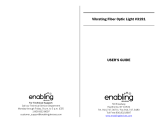
PPM-350C iii
Contents
Certification Information .................................................................................. v
European Community
Declaration of Conformity .......................................................................... vi
1 Introducing the PPM-350C PON Power Meter ......................... 1
Main Features ................................................................................................... 1
Available Models .............................................................................................. 3
Power Sources .................................................................................................. 3
Typical Applications .......................................................................................... 4
Conventions ...................................................................................................... 5
2 Safety Information ................................................................... 6
Laser Safety Information (Models with VFL) ...................................................... 6
Electrical Safety Information ............................................................................. 6
Ultra-High-Power™ Safety Information ............................................................. 7
3 Getting Started with Your PON Power Meter .......................... 8
Turning the Unit On and Off ............................................................................. 8
Activating Automatic Shutdown (Auto-Off) .................................................... 10
Installing the EXFO Universal Interface (EUI) ................................................... 10
Cleaning and Connecting Optical Fibers ......................................................... 11
Nulling Electrical Offsets ................................................................................. 12
4 Configuring Thresholds, Correction Factors, Wavelength List,
and Storage Details ................................................................ 13
5 Working in FTTx Mode ............................................................ 14
Selecting a Threshold Set ................................................................................ 14
Testing in Pass/Fail Mode or in Normal Mode .................................................. 16
6 Working in OPM Mode ............................................................ 18
7 Managing Test Results ............................................................ 19
Storing Data ................................................................................................... 19
Recalling Data ................................................................................................. 21
Deleting Data .................................................................................................. 22
Transferring Data to a Computer .................................................................... 22
8 Identifying Fiber Faults Visually ............................................. 23
9 Maintenance ............................................................................ 24
Cleaning EUI Connectors ................................................................................ 25
Replacing Disposable Alkaline Batteries .......................................................... 27
Recalibrating the Unit ..................................................................................... 27
Verifying the Integrity of User Information in Memory ................................... 28
Verifying the LEDs and LCD ............................................................................. 29
Recycling and Disposal (Applies to European Union Only) .............................. 29
10 Troubleshooting ...................................................................... 30
Solving Common Problems ............................................................................. 30
Error Codes and Descriptions .......................................................................... 31
Contacting the Technical Support Group ........................................................ 33
Transportation ................................................................................................ 34






















